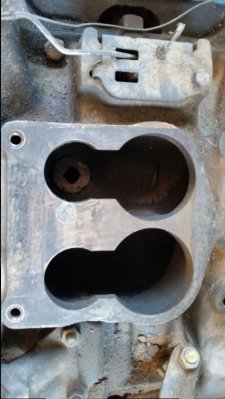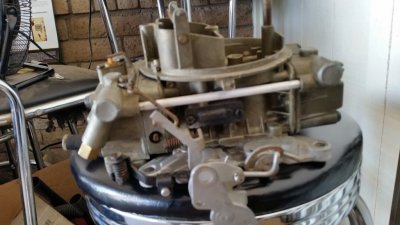You have a dual plain intake for a spread bore carburetor.
I apologize if you know this already.
- Square bore is all venturis the same or approximately the same size (which the 4160 will be) and spread bore have much larger secondaries.
- Intakes in the images at are 4 hole and 2 hole, or open. Take a look at http://www.440source.com/intakes.htm (your intake probably classifies as 2 hole) There are also open (which are on single plane intakes)
- Adapter plates can swap between spread bore and square bore carburetors and manifolds. You can also swap manifolds. 2 hole are more common on dual plane manifolds and 4 hole on single plane.
- Carburetor spacers. Using an open spacer connects all 4 barrels and allows all cylinders to draw on all four at high speed which can increase top end. Using a 4 hole (or 2 hole spacer) keeps them separate and increases the pull on the barrels which causes them to operate more efficiently at mid range. Spacers can also be made of insulating material (phenolic or wood) which help keep heat from the carburetor.
At a minimum, I think you need an adapter plate to match the 4160 to that manifold. I think I have seen them at the local advance auto so you probably can find quickly. That is a cheap solution and would allow you to continue your tests. In the longer term, you may want to replace the manifold, but I would think about getting all in order before doing that. If it were me, I would also want to make sure that the manifold (with EGR) was not a source of vacuum leaks or other problems. Make sure the plate doesn't lift the carburetor too high so there are clearance issues with the hood. It would stink to slam the hood down on the air cleaner or carburetor air cleaner stud.
Can I get some clarification on the situation. The 4412 you replaces was a 2 barrel, right??? If so I assume it was on a different manifold. The 4160 you just bought is what cfm? And is it new or used? I am asking because eventually you will probably want to adjust it and possibly the Jets. If it is new, my guess is you will be fine on jets to start, if used, you will want to check the jets to make sure it will not run too lean.


















